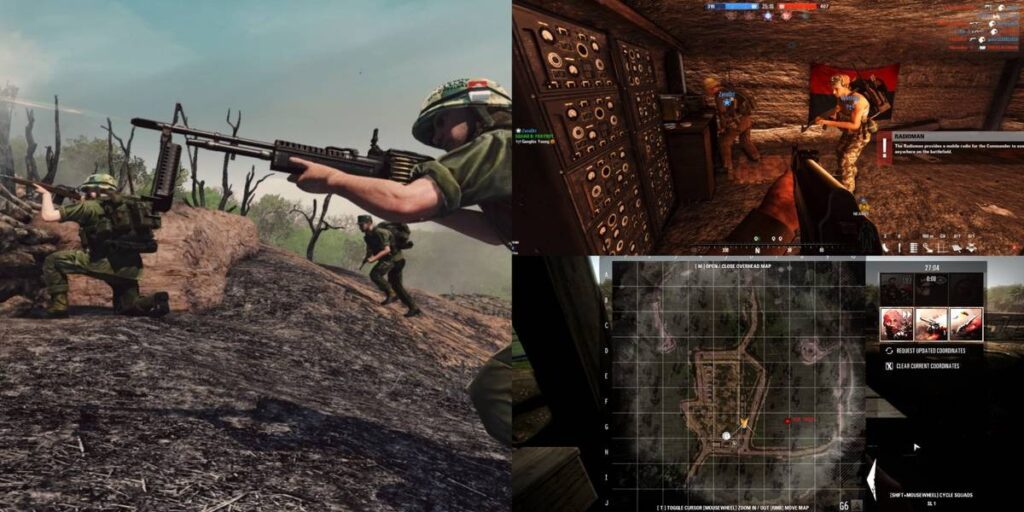The Vietnam War has long been one of the most atmospheric and challenging settings in the world of tactical shooters. Two games in particular—Rising Storm 2: Vietnam and the upcoming Hell Let Loose Vietnam—stand out for their unique approaches to recreating the conflict. While both promise intense firefights, gritty realism, and teamwork-driven combat, they cater to very different player experiences.
Rising Storm 2: Vietnam, released in 2017, is known for its fast-paced, asymmetric battles with 64-player matches. It throws players into chaotic jungles, villages, and tunnels where guerrilla tactics dominate, creating adrenaline-fueled encounters that never let up.
On the other hand, Hell Let Loose Vietnam, set for release in 2026, expands the war onto a larger, more strategic scale. With 100-player matches, logistics-driven gameplay, and sprawling maps, it emphasizes team coordination, communication, and immersion over raw reflexes.
This comparison dives into the setting, gameplay, weapons, vehicles, environments, and communities of both titles. Whether you’re a veteran of Rising Storm 2 or curious about the tactical depth promised by Hell Let Loose, this guide will help you decide which Vietnam War shooter best suits your playstyle.
1. Setting and Atmosphere
One of the biggest differences between Rising Storm 2: Vietnam and Hell Let Loose Vietnam lies in how each game captures the setting and atmosphere of the Vietnam War. Both titles draw from the same conflict, but their interpretations deliver very different experiences.
Rising Storm 2 thrives on intense, close-quarters chaos. Its maps drop players into tight jungles, villages, and rice fields where guerrilla warfare dominates. The game emphasizes the feeling of being constantly on edge—never knowing if an enemy is hiding in the foliage or preparing an ambush from the tunnels below. Explosions, napalm strikes, and frantic firefights create a fast-paced, high-pressure atmosphere that throws players directly into the heat of battle.
By contrast, Hell Let Loose Vietnam takes a more cinematic and large-scale approach. Its environments are broader, focusing on massive battlefields where squads must coordinate across open rice paddies, dense jungles, and strategic river crossings. The slower pace and larger scope build a sense of immersion that mirrors the grind of prolonged, tactical warfare. Instead of immediate chaos, players experience the weight of large operations, where teamwork and communication matter as much as individual skill.
Ultimately, both games succeed in capturing Vietnam’s brutal combat—but they do so in different tones: Rising Storm 2 thrives on raw intensity, while Hell Let Loose emphasizes strategic realism and immersion.
2. Gameplay Mechanics
When it comes to gameplay mechanics, Rising Storm 2: Vietnam and Hell Let Loose Vietnam share the same goal—immersive, tactical combat—but they execute it in very different ways.
Rising Storm 2 leans into fast-paced, action-heavy gameplay. With 64-player matches, firefights erupt quickly, and the pace is relentless. Players spawn closer to objectives, keeping the combat constant and chaotic. While teamwork is encourage, the game allows individuals to make a big impact with quick reflexes, aggressive play, and mastery of weapons. It blends historical authenticity with an accessible shooter feel, making it easier for new players to dive in while still rewarding skill.
On the other hand, Hell Let Loose Vietnam emphasizes slower, more tactical mechanics. With larger 50v50 battles, every move feels deliberate. Players must coordinate through squads, rely on leaders for strategy, and manage logistics like supplies and reinforcements. Respawn systems are stricter, encouraging careful planning rather than rushing into combat. Unlike Rising Storm 2’s constant adrenaline, Hell Let Loose thrives on tension and immersion, where communication and teamwork determine victory.
In short, Rising Storm 2 rewards quick action and adaptability, while Hell Let Loose Vietnam prioritizes patience, coordination, and strategic thinking. Both offer unique takes on Vietnam War combat, appealing to different playstyles—one focused on intensity, the other on tactical depth.
3. Weapons and Loadouts
A major part of any Vietnam War shooter is the arsenal, and both Rising Storm 2: Vietnam and Hell Let Loose Vietnam handle weapons and loadouts in ways that reflect their overall gameplay philosophy.
Rising Storm 2 offers a wide variety of authentic Vietnam-era weapons such as the AK-47, M16, M60 machine gun, flamethrowers, RPGs, and grenade launchers. Weapons feel powerful but relatively accessible, allowing players to pick them up and jump into the action quickly. Customization options and multiple class loadouts let players experiment with different playstyles, whether they prefer close-quarters ambushes or suppressive fire. The gunplay is designed to be intense and fast, mirroring the chaotic firefights of the war.
By contrast, Hell Let Loose Vietnam is expected to take a more realistic, role-based approach. Players won’t have free choice over all weapons—instead, loadouts are tied to specific squad roles, much like in the WWII version of Hell Let Loose. An infantry rifleman might carry an M16 or AK-47, while support roles handle heavier equipment like the M60, mortars, or flamethrowers. This system emphasizes teamwork, forcing squads to coordinate their firepower strategically rather than relying on individual flexibility.
In essence, Rising Storm 2 focuses on variety and accessibility, while Hell Let Loose Vietnam emphasizes authenticity and role-based realism. Both approaches capture the brutality of Vietnam combat but appeal to different styles of play.
4. Vehicles and Support
Vehicles and support options play a crucial role in shaping the battlefield, and both Rising Storm 2: Vietnam and Hell Let Loose Vietnam approach them in distinct ways.
Rising Storm 2 incorporates vehicles that reflect the high-tempo, action-heavy nature of its gameplay. The standout feature is the inclusion of helicopters, particularly the iconic Hueys, which provide rapid transport, aerial fire support, and a cinematic Vietnam War feel. Players can also call in napalm strikes, artillery barrages, and reconnaissance aircraft to influence the flow of battle. These support systems create moments of explosive chaos and keep matches unpredictable, reinforcing the game’s emphasis on intensity and spectacle.
In contrast, Hell Let Loose Vietnam is expected to lean heavily into its logistics-driven system. Vehicles such as armored personnel carriers (APCs), patrol boats, jeeps, and helicopters will likely be used not only for firepower but also for transporting squads and supplies across massive maps. Support in Hell Let Loose is tied to resource management and command structures—artillery strikes, air support, or vehicle deployments must be coordinated at the team level, requiring communication between commanders and squads.
While Rising Storm 2 uses vehicles to amplify adrenaline and action, Hell Let Loose Vietnam integrates them into a broader tactical ecosystem, where support and logistics are just as important as firepower. Both approaches capture different but equally vital aspects of the Vietnam War battlefield.
5. Maps and Environments
The environments of both Rising Storm 2: Vietnam and Hell Let Loose Vietnam are central to how each game delivers its version of the Vietnam War experience. While both feature jungles, villages, and rural landscapes, the way these maps are designed—and how they affect gameplay—differs greatly.
Rising Storm 2 focuses on medium-scale, close-quarters maps that emphasize the chaos of guerrilla combat. Dense jungles, rice paddies, small villages, and tunnel networks create opportunities for ambushes and frantic firefights. The map layouts encourage fast-paced engagements, where danger lurks around every corner. These compact environments deliver adrenaline-fueled gameplay but keep battles contained, ensuring action is never far away.
On the other hand, Hell Let Loose Vietnam is expected to embrace massive, sprawling battlefields, in keeping with the series’ tradition of large-scale warfare. Players can anticipate open rice fields, thick forests, river crossings, and multi-layered terrain that require squads to move strategically and coordinate over long distances. Features like tunnel systems, dynamic weather, and day-night cycles may add depth, realism, and unpredictability. The larger scale means encounters will feel more tactical, with room for flanking maneuvers, supply routes, and vehicle integration.
In short, Rising Storm 2 thrives on intense, close-up encounters, while Hell Let Loose Vietnam emphasizes immersion, scale, and tactical diversity. Together, they showcase two very different but equally compelling visions of Vietnam War battlefields.
6. Community and Learning Curve
A game’s community and learning curve often determine how accessible it is to new players and how rewarding it becomes for veterans. In this regard, Rising Storm 2: Vietnam and Hell Let Loose Vietnam take notably different paths.
Rising Storm 2 has a reputation for being intense but relatively approachable. While teamwork enhances the experience, individual skill—quick reflexes, weapon mastery, and map awareness—can still carry a player through matches. The learning curve exists, especially with asymmetric gameplay between factions, but new players can generally jump in, contribute, and start enjoying the action fairly quickly. The community is known for being passionate and dedicated, with many veterans offering guidance to newcomers.

By contrast, Hell Let Loose Vietnam is expected to present a steeper learning curve. Success depends heavily on communication, coordination, and understanding squad roles. New players may find it overwhelming at first, as the game demands patience, teamwork, and strategic thinking rather than lone-wolf action. However, this creates one of the most rewarding tactical FPS experiences once players adapt. The Hell Let Loose community is known for its commitment to realism and cooperation, often welcoming rookies who are willing to listen and learn.
In short, Rising Storm 2 offers a faster, more accessible entry point, while Hell Let Loose Vietnam provides deeper, more demanding tactical immersion. Both communities thrive on teamwork, but they cater to different levels of player dedication.
7. Which Game is Right for You?
Choosing between Rising Storm 2: Vietnam and Hell Let Loose Vietnam ultimately depends on what kind of tactical shooter experience you’re looking for. Both games recreate the chaos of the Vietnam War but cater to very different playstyles.
If you prefer fast-paced, action-heavy gameplay, Rising Storm 2 is likely the better fit. Matches are shorter, maps are tighter, and firefights are immediate. It rewards sharp reflexes, aggressive play, and quick decision-making, while still offering authentic Vietnam-era weapons and asymmetric gameplay. For players who want to jump into the action and feel the intensity of jungle combat without a steep learning curve, Rising Storm 2 is the way to go.
On the other hand, if you enjoy large-scale battles, slower pacing, and deep tactical coordination, Hell Let Loose Vietnam will suit you better. With massive 50v50 matches, role-based squads, and logistics-driven systems, it emphasizes teamwork, communication, and strategy. The learning curve is tougher, but the reward is a more immersive, large-scale war simulation that captures the grind and complexity of Vietnam combat.
In short: Rising Storm 2 is ideal for adrenaline seekers who want accessible but intense firefights, while Hell Let Loose Vietnam is perfect for players seeking a realistic, team-driven war experience. Both deliver on atmosphere—your choice comes down to speed vs strategy.
8. Conclusion
Both Rising Storm 2: Vietnam and Hell Let Loose Vietnam capture the brutality and atmosphere of the Vietnam War, but they do so in very different ways. Rising Storm 2 delivers fast-paced, adrenaline-fueled matches filled with chaotic firefights and guerrilla ambushes—perfect for players who want action without heavy reliance on long-term strategy. Meanwhile, Hell Let Loose Vietnam emphasizes scale, realism, and squad coordination, offering a slower but more immersive experience where teamwork and communication are the keys to victory.
Neither title is “better” in every sense; instead, they cater to distinct player preferences. If you want quick intensity, Rising Storm 2 is ideal. If you crave large-scale tactical warfare, Hell Let Loose Vietnam may be the ultimate choice.
In the end, both games enrich the tactical shooter genre and ensure the Vietnam War setting continues to thrive in modern FPS gaming.




Pingback: Hell Let Loose Vietnam: What We Know So Far - Lakho Bytes